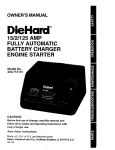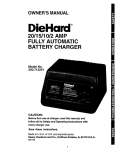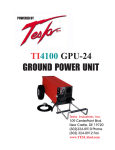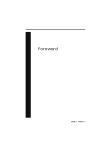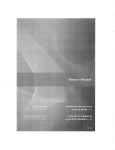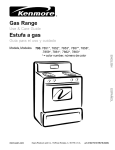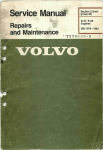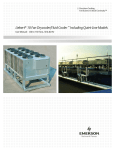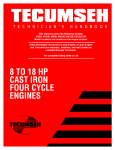Download DieHard 200.713121 Owner`s manual
Transcript
OWNER'S MANUAL ® 12/2/75 AMP FULLY AUTOMATIC BATTERY CHARGER ENGINE STARTER Model No. 200.713121 CAUTION: Before first use of charger, read this manual, and follow all its Safety and Operating Instructions with every charger use. Save these instructions. Made in U.S.A. of U.S. and imported pads. Sears, Roebuck and Co., Hoffman Estates, IL 60179 U.S.A. 598-198 WARRANTY ............................................................................................................... 2 SAFETY ..................................................................................................................... 3 Important Safety Instructions .................................................................................... OPERATION .............................................................................................................. Before Using Your Battery Charger .......................................................................... 3 4 5 Assembling your charger ..................................................................................... 5 Plugging it in ........................................................................................................ 5 Using an extension cord ...................................................................................... 5 Preparing Your Battery to be Charged ...................................................................... 6 Using Your Battery Charger ...................................................................................... 6 Setting the controls .............................................................................................. 6 Charging your battery ........................................................................................... 8 Inside vehicle ................................................................................................... 8 Outside vehicle ............................................................................................... 9 Using the Engine Start Feature .............................................................................. 10 Calculating 11 Charge Time ......................................................................................... MAINTENANCE AND CARE .................................................................................... TROUBLESHOOTING ............................................................................................ PARTS ..................................................................................................................... Wiring Diagram ................................................................................................. 12 13 14 15 Please read this Owner's Manual before using your Battery Charger The DieHard model 200.713121, Fully Automatic Battery Charger/Engine Starter, offers a wide range of features for home or light commercial use. This manual will show you how to use your charger safely and effectively. Please read and follow these instructions and precautions carefully. FULL THREE YEAR WARRANTY Within three years from the date of purchase, this battery charger fails due to a defect in materials or workmanship, RETURN IT TO TH E PLACE OF PURCHASE, and itwill be repaired or replaced free of charge. This warranty gives you specific legal rights, and you may also have other rights which vary from state to state. Sears, Roebuck and Co., Dept. 817WA, Hoffman Estates, IL 60179 2 WARNING: To reduce the risk of HELP US HELP YOU -- explosion, explosive gases, or injury while using your battery charger, follow the precautions • Remember: listed below: • • Do not expose charger to rain or snow. Usechargeronlyon lead-acidtype rechargeable batteries, such as those used in cars, trucks, tractors, airplanes, vans, RV's, trolling motors, etc. This charger is not intended to supply power to a low voltage electrical system. Use only attachments recommended or sold by manufacturer. The use of attachments not recommended by the manufacturer may result in fire, electric shock, or injury. • Do not disassemble charger. Take it to a qualified service professional if service or repair is required. Incorrect assembly may result in fire or electrical shock. • To reduce risk of electrical shock, unplug the charger from the outlet before attempting any maintenance cleaning. • Never charge a frozen battery. If battery fluid (electrolyte) becomes frozen, bring battery into a warm area to thaw before you begin charging. • Never allow battery acid to drip on charger when reading specific gravity or filling battery. • Never set a battery on top of the charger. • Never place charger directly above battery being charged. The gases from the battery will corrode and damage the charger. • Never use charger for charging drycell batteries that are commonly used with home appliances like radios, stereos, remote controls, etc. These batteries may burst and cause personal injury. • Never touch the battery clamps together when the charger is on. You will cause a spark. • Never operate charger if it has received a hard blow, been dropped, or otherwise damaged. Take it to a qualified professional for inspection and repair. entirecharger. • Do not set charger on flammable materials like carpeting, upholstery, paper, cardboard etc. Charger may damage leather and melt plastic and rubber. Be sure to position the charger power cord tOprevent it from being stepped on, tripped over, or damaged. • Never pull out the plug by the cord when unplugging the charger. Pulling on the cord may cause damage to the cord orthe plug. • Do not operate the charger if it has a damaged power cord or plug. Have the cord replaced. • Always charge battery in a well ventilated area. • Batterychargersget hot during operation and must have proper ventilation. Air needs to flow around • Place charger as far away from battery being charged as the charger cables will permit. Read all instructions and cautions printed on the battery charger, battery, and vehicle or equipment using battery. • • or 3 Personal Safety Precautions For your own personal safety, please follow the following precautions: Wear complete protection when working acid batteries. with lead- • Be sure that someone is within range of your voice to come to your aid if needed while you work with or are near a lead-acid battery. • Have plenty of fresh water and soap nearby for use in case battery acid contacts your eyes, skin, or clothing, if this happens, wash immediately with soap and water. Then get medical attention. • Remove all personal metal items eye and clothing from your body, such as rings, bracelets, necklaces, and watches while working with a lead-acid battery. A battery can produce a short circuit current high enough to weld a ring (or the like) to metal, causing a severe burn. Avoid touching your eyes while working with a battery. Acid particles (corrosion) may get into your eyes. If this occurs, flush eyes immediately with running cold water for at least 10 minutes. Then immediately get medical attention. 4 • Take care not to drop any metal tool or metal object onto the battery. This may spark or short circuit the battery or another electrical device that may cause an explosion. • Always operate your battery charger in an open, well ventilated area. • Never smoke or allow a spark or flame in the vicinity of the battery or engine. Batteries generate explosive gases. • Neutralize any acid spills thoroughly with baking soda before attempting to clean up. It is impodant to understand your charger's requirements. This section will tell you about your charger's electrical requirements and how to prepare a battery for charging. ASSEMBLING YOUR CHARGER Included with your battery charger are two cord wrap posts for storage of the clamp cables. To install, align the three tabs to correspond with the three receptacles and push until you hear a snap. Wrap clamp cord after unplugging the power cord and store your charger in a dry location. PLUGGING [_ IT IN (--Cord Wrap Cleat USING AN EXTENSION CORD The use of an extension cord is not WARNING: Electrical Shock Hazard. Be sure that the power cord fits properly into the outlet. If not, have a qualified technician install a proper outlet. Never alter the AC cord or plug provided. recommended. If you must use an extension cord, please make sure that you follow these guidelines: • Improper connection can result in electrical shock. Make sure that the pins on charger's power cord fit firmly into the extension cord, and that the extension cord fits firmly into the receptacle. Your charger requires a 120V receptacle installed according to all local codes and ordinances. • Check that the extension cord is properly wired and in good electrical condition. Make sure that the wire size is large enough for its length and for the AC ampere rating as specified in the chart below. Length of Cord, In Feet 25 50 100 AWG* Size of Cord 18 16 *AWG=American Wire Gauge 5 12 150 10 It is important that you read and follow these guidelines while you are preparing to charge your battery. caps while charging, and recommended rates of charge. Make sure that you have a 12 volt or 6 volt lead-acid battery. Set the selector switch to match the voltage rating of the battery to be charged. Wear safety glasses. See additional "Personal Safety Precautions" on page 4. Clean the battery terminals. Be careful to keep corrosion from getting in or around your eyes. • battery is well ventilated while it is being charged. For batteries with removable cell caps, if required by the manufacturer, add distilled water to each cell until the If it is necessary to remove the battery from the vehicle to charge it, always remove the grounded terminal from the battery first. Turn off all vehicle accessories to avoid sparks from occuring. battery acid reaches the level recommended. This will help purge excessive gases from the cells. Be careful not to overfill. If you have a sealed battery without cell caps, no action is necessary. Continue to the next step listed below. • Be sure that the area around the NOTE" A marine battery installed in a boat must be removed and charged on shore. Take time to read all battery manufacturer's specific precautions, such as removing or not removing cell To obtain the best results from your battery charger, you must know how to use it properly. This section will tell you how to set the controls, how to charge a battery in or out of a vehicle, and how to use the engine start feature. SETTING THE CONTROLS All controls are located on the front of • Use the right switch to select a charge rate--2 AMP charge, 12 AMP charge, or 75 AMP ENGINE START. the charger. Follow these instructions to obtain the correct charge level for your battery. SELECTOR Battery Voltage: Select the voltage of your battery. The most common applications will be 12 volt. SWITCHES: Your charger has three switches: • Use the left switch to match the battery voltage--either 6 or 12 volt. • Use the center switch to select a 6 VOLT charge type_MANUAL, AUTOMATIC DEEP CYCLE or AUTOMATIC REGULAR. 6 12 VOLT AMMETER: The ammeter indicates the measured amount of amperes being drawn by the battery. When you first start charging a battery, the reading will be high, with the needle near 12 using the 12 amp charging rate. • In the MANUAL setting, as the battery charges, the needle will fall to about 5 to 6 amps, indicating a charged battery. Charge Type: • Use the MANUAL setting only if you check the charging progress frequently. The charger will not stop charging when the battery reaches full charge, possibly damaging the battery if left on too long. You must monitor and unplug the charger when battery is fully charged. • Use the AUTOMATIC DEEP CYCLE setting for all deep cycle battery charging. The charger will automatically stop charging when the battery reaches full charge and begin charging again when battery requires. • Use the AUTOMATIC In both AUTOMATIC settings, the needle will fall to zero and the charger will shut off when the charger's control circuit senses a full charge. A freshly charged battery's voltage will drop shortly after charging stops, and the charger, if left connected, may resume charging. This off-and-on cycling will continue until the battery's voltage no longer drops enough to restart the charger. REGULAR setting for all but deep cycle batteries. The charger will automatically stop charging when the battery reaches full charge and begin charging again when battery requires. • A severely discharged battery may not have enough charge to start the control circuit in an AUTOMATIC • setting. In this case, charge on MANUAL until the battery has enough charge to accept an AUTOMATIC setting. AUTOMATIC At the 2 amp charging rate you will notice very little needle movement. When cranking the engine while using the ENGINE START feature, the needle will swing into the Start (red) area of the scale. DEEP CYCLE v AUTOMATIC REGULAR II............. MANUAL Charge Rate: • Use the 2 AMP charge rate setting for charging small batteries and warming large batteries.The lower the charge rate, the longer it will take to charge the battery. CHARGE % 0 4 2 100 75 6 8 50 10 25 12 O FULL CHARGE LED INDICATOR: • Use the 12 AMP rate setting for automotive, deep cycle and other large batteries. The green LED INDICATOR will glow when the charger senses that the battery has reached a full charge. • Use the 75 AMP ENGINE START setting only to assist in cranking the engine. • When using the MANUAL charge rate, stop charging when the LED glows and the AMMETER needle is about 5 to 6 amps in the 12 Amp setting. 12AMP 2 AMP DCAMPS ENGINE START 7 Fordeep cycle batteries,you may wish to allowthe batteryanotherone or two hoursof chargingafter the LED glows to obtaina maximumcharge. When usingthe AUTOMATICcharge rates,the LEDwill cycle on and off indicatingthe charger is maintaining the battery'sstate-of-charge. CHARGING YOUR BA'I-rERY NEGATIVE Charging your battery inside the vehicle: Keep clear of fan blades, belts, pulleys, and other parts that can cause injury. 3. Check the polarity of the battery posts as indicated on the battery case: POSITIVE (POS, P, or +) and NEGATIVE (NEG. N or -). NOTE: The positive post on toppost battery is usually larger than the negative post. 4. SYSTEM connect the red (POSITIVE) clamp to a heavy, unpainted metal part of the chassis or engine block, away from the battery. DO NOT connect clamp to carburetor, fuel lines, or sheet metal parts. IMPORTANT: Wear safety glasses and turn face away from the battery when making connections. 1. Arrange the powercord and charging leads carefully to avoid damage that could be caused by the hood, door, or moving engine pads. 2. GROUNDED Figure A . For automatic charging, select AUTOMATIC DEEP CYCLE or AUTOMATIC REGULAR as a charge type, then select a charge rate. The charger will stop charging when the battery is fully charged. Identify which battery post is ground or connected to the chassis. THE NEGATIVE POST IS NORMALLY THE ONE THAT IS GROUNDED. . 5. To charge a negative grounded post system: Connect the red (POSITIVE) battery charger clamp tothe ungrounded POSITIVE (POS, P, +) post of the battery. Rock or twist the clamps back and forth to make a solid connection. Then connect the black (NEGATIVE) clamp to a heavy, unpainted metal part of the chassis or engine block, away from the battery. DO NOT connect clamp to carburetor, fuel lines or sheet metal parts. (See Figure A.) To charge a positive grounded post system: Connect the black (NEGATIVE) battery charger clamp to the ungrounded NEGATIVE (NEG, N, -) post of the battery. Then . For manual charging, select MANUAL as a charge type then select a charge rate. The charger will not stop charging when the battery is fully charged--you must monitor and unplug charger when battery is fully charged. Avoid over charging, monitor the AMMETER frequently when in the MANUAL mode. Next plug the power cord into an AC outlet. 9. When the battery is fully charged, in the MANUAL mode, the AMMETER pointer will fall to about half the charge rate selected. For specific positions, refer to the "Ammeter" section in "Using Your Battery Charger" on page 6. 10. When the battery is fully charged, unplug the charger power cord before attempting to disconnect charger clamps. 8 10. When the batteryis fully charged, first unplugthe chargerpower cord. Then, standingawayfrom the battery, removethe charger clampfrom the chassis first, then from the battery post. POSRIVE POWER 24", 6 GAUGE CABLE 11. Clean andstore the batterycharger in a dry location. GROUNDED POWER Charging your battery outside the vehicle: Figure 1. Remove the battery from vehicle, making sure to disconnect grounded terminal first with all accessories and lights turned off in the vehicle. . 2. Check the polarity of the battery posts as indicated on the battery case: POSITIVE (POS, P, +) and NEGATIVE (NEG, N, -). NOTE: On top-post batteries, the positive battery terminal usually has a larger diameter post than the negative one. , 3. Connect the red (POSITIVE) charger clamp to the POSITIVE post of the battery. Be sure to rock the clip back and forth to make a solid connection. . 4. Attach a 6-gauge (AWG) or a 4-gauge (SAE) insulated battery cable at least 24-inches long to the NEGATIVE battery post. This cable will provide a safer connection, if arcing and sparking occur, it will be at a distance from the battery. NOTE: The battery cable is not provided with the charger, but may be purchased at most automotive stores. B OUTLET For automatic charging, select AUTOMATIC REGULAR or AUTOMATIC DEEP CYCLE depending on the type of battery, then select a charge rate. The charger will quit when the battery is fully charged and will restart if the battery voltage drops too low. For manual charging, select MANUAL as a charge type then select a charge rate. The charger will not stop charging when the battery is fully charged; you must monitor and unplug charger when battery is fully charged. Avoid over charging; monitor the AMMETER frequently when in the manual mode. Plug the power cord into an AC outlet. 9. When the battery is fully charged in the MANUAL mode, the AMMETER pointer will fall to about half the charge rate selected. For specific positions, refer to the "Ammeter" section in "Using Your Battery Charger" on page 6. 10. When the battery is fully charged, unplug the charger power cord before attempting to disconnect charger clamps. 5. Take the other end of the 6-gauge (AWG) or a 4-gauge (SAE) insulated 24-inch cable and, standing as far away from the battery as possible, connect the black (NEGATIVE) lead of the charger to the free end of the cable. Rock the clamp to make a solid connection. IMPORTANT: Wear safety glasses and face away from the battery while making this final connection. 11. Standing away from the battery, remove the negative lead from the insulated cable connected to the NEGATIVE post first. Then remove the lead from the POSITIVE post. 12. Clean and store the charger in a dry location. 9 Your battery charger can be used to jump start your car if the battery is low. Follow these instructions on how to use the ENGINE START feature. 4. After the engine starts, unplug the charger power cord from the AC outlet. Then disconnect the charger from the battery. 1. Connect the charger to the battery and vehicle as instructed in the "Charging your battery" section on page 8. 2. Set the right hand SELECTOR SWITCH on ENGINE START. IMPORTANT: Do not try to start the engine without a battery in it. You could cause damage to the electrical system. 3. Crank the engine for no more than 5 seconds. If it does not start, wait at least 4 minutes before cranking again. In extreme cold or if the battery is severely discharged, charge the battery in the 12 amp position for about 5 minutes before cranking the engine. If the engine does turn over, but never starts up, there is not a problem with the starting system, there is a problem somewhere else in the vehicle. STOP cranking the engine until the other problem has been identified and corrected. 10 Battery Rating Method Use the following table to more accurately determine the time it will take to fully charge a battery that is initially at 50% State-of-Charge. Identify your battery type and its associated Charge Time in the table. Common battery types are: • Small batteries, motorcycles, (AH). garden tractors, etc., are usually rated in Amp-Hours • Car and truck batteries, usually rated in Reserve Capacity (RC), Cold Cranking Amps (CCA), or both. • Marine, or deep cycle batteries, usually rated in either Amp-Hours Capacity (RC). or Reserve Charge Time Table for Batteries at 50% State-of-Charge AH Motorcycle and tractor RC 2 AMP 12 AMP 75 AMP 6-12 2-4 NA NA 12 - 32 4-10 NA NA Car and Truck Marine and Deep Cycle NA = Not Allowed. Voltmeter CCA 40 - 60 200 - 315 8-11 1-2 NA 60 - 85 315 - 550 11 - 16 2-3 NA 85-190 550- 16 - 35 1000 NA 3 - 53/_ 40 8O 15 2½ NA 8O 14O 26 4½ NA 95 160 30 5 NA 105 180 33 5½ NA DO NOT charge at this setting Method To find the time needed to fully charge your battery, determine the battery's charge level with a voltmeter or electronic State-of-Charge Tester. Use the table below to convert Voltmeter and State-of-Charge readings at room temperature to the appropriate Charge Factor. Then use the formulas that follow the table to determine the approximate Charge Time. Charge iiiiiiii_iiiii iiili iiiiiii_iiiiiiii ii !iiiiiii;iii_i_:_ii i i!iiiii_!iiiiiiiiiii:iiiiiiiiii_iii Voltmeter B_ _g il;!i!! iiiliiii ii Factor Table ii;_;ii 12 Volt Battery 6 Volt Battery 12.67 6.34 100% 0 12.45 6.22 75% 0.25 12.25 6.12 50% 0.50 12.06 6.03 25% 0.75 11.86 5.93 0% 1 11 Charge Time Needed if Amp-Hours is Known • Find the Charge Factor for your battery in the table on page 11. • Multiply by the Amp-Hour rating of the battery. • Divide by the Charger Setting (either 2 Amp or 12 Amp). • Multiply by 1.25 to get the approximate Hours Neededto bring the battery to full charge. Example: 15Amp-Hour (AH) Battery, 50% State-of-Charge, 2 Amp Charger Setting [(AH x Charge Factor) ÷ Charger Setting] x 1.25 = Hours Needed (15 x 0.5 + 2) x 1.25 = 4.7 Hours Charge Time Needed if Reserve Capacity is Known • Find the Charge Factor for your battery in the table on page 11. • Multiply by the Reserve Capacity rating of the battery. • Divide by the Charger Setting (either 2 Amp or 12 Amp). • Multiply by 0,73 to get the approximate full charge. Example: Hours Needed to bring the battery to 95-Minute Reserve Capacity (RC) Battery, 25% State-of-Charge, 12 Amp Charger Setting [(RC x Charge Factor) + Charger Setting] x 0.73 = Hours Needed [(95 x 0.75) + 12] x 0.73 = 4.3 Hours To keep your battery charger working properly for years: 1. Clean the clamps each time you are finished charging. Wipe off any battery fluid that may have come in contact with the clamps to prevent corrosion. 2. Coil the input and output cords neatly when storing the charger. This will help prevent accidental damage to the cords and charger. 12 Performance problems often result from little things that you can fix yourself. Please read through this chart for a possible solution if a problem occurs. No ammeter reading Clamps not making good connection. Check for poor connection at battery. Make sure clamps and posts are clean. Battery may not accept an AUTOMATIC charge if severely discharged. Use MANUAL setting, see "Using Your Battery Charger" on page 6. 2-amp charge rate. Ammeter needle will indicate little activity at the 2-amp charge rate. No AC power reaching charger. Check AC outlet and extension cords for loose fitting plug. Check for open fuse or circuit breaker supplying AC outlet. Circuit breaker in Shorted battery clamps. Separate the clamps. Circuit breaker cycles when current draw is too high. Check for worn cables and replace if needed. Shorted battery. Have a Sears technician test the battery. Charger leads reversed on battery. Correct connections. charger cycles on and off with a clicking sound in the MANUAL setting. Ammeter reads less than selected charge rate when charging. Charger makes a loud buzz or hum. Short start cycle when cranking engine. Extension cord too long or gauge too small. ! Use shorter or heavier extension cord. Battery has weak cell or Sulfated battery will eventually take a sulfated plate. normal charge if left connected. If the battery will not take a charge, have it tested by a Sears technician. Battery is partially charged. Continue charging Transformer laminations vibrate (buzz). Continue charging. Buzz is not abnormal. Shorted diode (hum). Have charger tested by qualified technician. Drawing more than 75 amps 7 seconds or less. Crank time varies with the amount of current drawn from the charger. If cranking draws more than 75 amps, crank time may be less than 7 seconds. Failure to wait for 4 Wait 4 minutes before next crank. battery. minutes (240 seconds) between cranks. If the above solutions 1-000-SEARS-64 do not eliminate the problem,..call ton-free from anywhere in the U.S.A. • (1400-732-7764) 7 AM to 4:30 PM CST Monday through Friday 13 This section shows an illustration of your battery charger. Use it to become familiar with where all the parts are located, and what they look like. Item 1 Description Transformer Item Description Part Number 93026483 8 Handle Switch-left Part Number 3599000270 2 Diode Asm Kit 2299000976 9 3 PC Board Asm 2299000966 Circuit Breaker 3999000088 Switch - ri_lhtDPDT Meter 0499000068 4 10 11 5 DC Cable Asm 3899000850 12 Cord Wrap Cleats 1199004390 6 SCR 55A 3100300017 13 Owner's Manual 0000000598 7 Power Cord 90026111M 14 Faceplate 0899001076 14 DPDT 0499000060 5399100093 (-) i _313_ 15 For information about troubleshooting Call toll-freefrom anywhere in the U.S.A. 7 am to 4:30 pm CST Monday through Friday 1-800-732-7764 For the repair or replacement parts you need Call 7 am - 7 pm, 7 days a week 1-800-366-PART (1-800-366-7278) For the location of an authorized Sears Service Center in your area Call 24 hours a day, 7 days a week 1-800-488-1222 When requesting service or ordering parts, always provide the following information: • ProductType: 12/2/75 AMP • Fully Automatic Battery Charger Model Number: 200.713121 • Part Number (See Page 14) • Part Description (See Page 14)
















